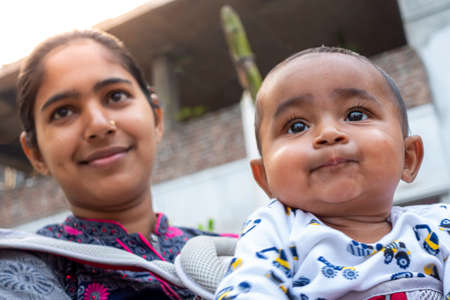Introduction to Childbirth in India
Childbirth holds immense cultural, emotional, and social significance in Indian society. Across the vast and diverse country, the experience of bringing a child into the world is shaped by centuries-old traditions, family values, and evolving medical practices. Traditionally, normal or vaginal delivery has been regarded as the natural and preferred method among many Indian families, especially in rural areas where age-old beliefs and community wisdom play a strong role. The event of childbirth is often celebrated as a collective family occasion, with elders guiding expectant mothers through pregnancy and delivery based on ancestral knowledge.
However, as India continues its journey towards modernization, there is a growing influence of modern healthcare systems, especially in urban centers. Hospitals and clinics are now more accessible, and awareness about different birthing options has increased among both parents and healthcare providers. This shift has brought about changes in perceptions regarding caesarean (C-section) deliveries versus normal deliveries. While C-sections were once considered only in emergency situations or when medically necessary, they have become more common in recent years due to a variety of medical, social, and sometimes even personal preferences.
The coexistence of traditional beliefs and contemporary medical advancements creates a unique landscape for childbirth choices in India. Understanding how families—especially fathers—navigate these choices requires an appreciation for both the cultural reverence for motherhood and the practical considerations influenced by education, healthcare access, and economic factors. As we explore the trends in normal versus caesarean deliveries across rural and urban India, it becomes clear that childbirth methods are deeply entwined with societal values, generational advice, and the aspirations of modern Indian families.
2. Understanding Normal and Caesarean Deliveries
When we talk about childbirth in India, especially as a father wanting the best for his family, it’s essential to understand the two main ways babies are born: normal (vaginal) delivery and caesarean (C-section) delivery. Both have their own place in our healthcare system and are understood differently in rural and urban settings.
Normal Delivery: What is it?
In Indian households, especially in rural areas, “normal delivery” or sadharan prasav is often considered the natural way for a baby to come into this world. This means the baby is born through the birth canal without surgical intervention. Many families believe normal deliveries lead to faster recovery for mothers, less hospital stay, and fewer complications. In cities, this method is also called “vaginal birth.”
Caesarean Delivery: What does it mean?
A caesarean delivery, known commonly as C-section or operation se bachcha paida hona, involves delivering the baby surgically through an incision in the mother’s abdomen and uterus. In urban India, C-sections are seen as a safer alternative when there are complications or risks to mother or child. However, in rural areas, many still see C-section as something only needed if there are “problems” during labour or if advised strongly by doctors.
Key Differences at a Glance
| Type of Delivery | Common Indian Term | Typical Perception (Rural) | Typical Perception (Urban) |
|---|---|---|---|
| Normal/Vaginal Delivery | Sadharan Prasav/Prakritik Janm | Preferred, natural, less costly | Preferred if no complications; considered safe and healthy |
| Caesarean Delivery (C-section) | C-section/Operation Se Bachcha Paida Hona | Avoided unless necessary; sometimes associated with higher costs or risk | Seen as modern, often done for safety reasons or convenience |
The choice between these two types of deliveries depends on health conditions, doctor’s advice, and sometimes family beliefs. As fathers and family members, understanding both options helps us support our wives and make informed decisions together. Whether you’re from a metro like Mumbai or a small town in Uttar Pradesh, knowing these terms and cultural attitudes prepares you for meaningful participation in your child’s birth journey.

3. Trends in Rural vs Urban India
When we look at the trends of normal versus caesarean deliveries across rural and urban India, there are some striking differences that emerge. In rural regions, normal (vaginal) deliveries still remain the most common method due to a variety of reasons. Limited access to advanced healthcare facilities, lower awareness about caesarean options, and strong family preferences for traditional birth practices all play a role in these areas. On the other hand, urban India has witnessed a significant rise in caesarean sections over recent years.
Statistics Highlighting the Gap
According to the National Family Health Survey (NFHS-5), only about 13% of births in rural India are via caesarean section, compared to nearly 36% in urban areas. This gap shows how much location influences the choice of childbirth method. In metros like Delhi, Mumbai, and Bengaluru, it is not uncommon for private hospitals to report even higher rates of C-section deliveries, sometimes upwards of 50%. The reason behind this sharp divide is multifaceted and often includes better access to healthcare infrastructure, greater medical intervention, and changing parental preferences in cities.
Healthcare Access as a Deciding Factor
One of the main reasons for higher normal delivery rates in villages is the availability—or lack—of quality hospitals and trained obstetricians. Most Primary Health Centres (PHCs) in rural India are equipped for uncomplicated vaginal deliveries but may not be prepared or staffed for emergency caesareans. Urban families have quicker access to multispeciality hospitals with full surgical backup, making C-sections a safer option if any risk arises during labour.
Awareness and Family Preferences
In rural households, there is often a generational preference for natural births, influenced by community norms and advice from elders. Many women also feel social pressure to opt for normal delivery unless medically necessary otherwise. In contrast, urban parents—especially first-time mothers—may lean towards caesarean sections either out of concern for convenience or fear of labour pain, given greater exposure to information from doctors and online sources.
The Changing Scenario
While tradition still strongly guides childbirth choices in rural India, increasing education and government initiatives are slowly bridging the knowledge gap. However, until infrastructure catches up with demand and awareness spreads evenly across all regions, these disparities between rural and urban delivery trends are likely to continue.
Cultural Influences and Family Decisions
In India, the choice between normal (vaginal) and caesarean delivery is deeply intertwined with cultural beliefs, family dynamics, and societal expectations. Unlike many Western countries where decisions are often left to the expectant mother and her doctor, Indian families—especially in rural areas—play a significant role in childbirth choices. Fathers, mothers-in-law, and elders usually participate actively in these discussions, drawing from tradition, perceived safety, social status, and personal experiences.
The Role of Elders and Fathers
Traditionally, Indian society places great respect on the wisdom of elders. Their experiences and opinions heavily influence family decisions, especially regarding childbirth. While urban families may consult medical professionals more frequently, rural households tend to rely on community knowledge and local practices. Fathers are also becoming increasingly involved in these decisions as awareness grows about different delivery methods and their potential impacts on both mother and child.
Key Factors Influencing Delivery Method Decisions
| Factor | Normal Delivery Preference | Caesarean Delivery Preference |
|---|---|---|
| Cultural Beliefs | Seen as natural; associated with faster recovery for mothers; aligns with traditional values | Sometimes viewed as a modern or prestigious option; may be preferred if there are superstitions about auspicious birth timings |
| Family Pressure | Elders may encourage normal delivery based on their own experiences | Families sometimes opt for C-section to avoid perceived risks of complications during labor |
| Medical Advice Acceptance | More common in urban areas where families trust doctors’ recommendations for normal delivery | In some cases, families insist on C-section despite medical advice due to fear or convenience (e.g., avoiding labor pain) |
| Practical Considerations | Lower cost compared to C-section; easier access in government hospitals in rural areas | C-section may be chosen if families can afford private care or when timely access to skilled healthcare is available in cities |
The Impact of Social Narratives and Myths
Indian society is filled with stories about childbirth—some rooted in fact, others in myth. For example, some believe that C-sections result in healthier babies or prevent future health problems for mothers. Others think that only “strong” women can deliver normally, which sometimes puts undue emotional pressure on expecting mothers. These narratives circulate among family gatherings and play a strong role in shaping decisions.
As a father myself living in India, I have seen how challenging it can be to balance family expectations with medical advice. Open conversations between all family members—including fathers—do help bridge the gap between tradition and modern healthcare. Ultimately, every family’s decision is shaped by a unique combination of cultural heritage, access to information, emotional readiness, and practical realities.
5. Healthcare Infrastructure and Its Impact
When we discuss the differences in normal versus caesarean delivery trends across rural and urban India, it is impossible to ignore the role played by healthcare infrastructure. Cities like Mumbai, Delhi, or Bangalore are equipped with multi-specialty hospitals, private clinics, and a wide network of medical professionals. These facilities offer advanced maternal care and make both normal and caesarean deliveries accessible round the clock. On the other hand, rural India often depends on primary health centres (PHCs), government hospitals, or local clinics with limited resources and staff.
Quality of Healthcare Facilities
The quality of healthcare services varies drastically between urban and rural areas. In cities, expectant mothers benefit from state-of-the-art diagnostic tools, experienced gynaecologists, and regular antenatal check-ups. This increases the likelihood of early detection of complications that may necessitate a C-section. Conversely, in villages, even basic ultrasound or emergency care may be unavailable, leading families to rely more on traditional birth attendants or opt for normal deliveries at home.
Availability and Accessibility
In urban India, pregnant women usually have easy access to hospitals within a few kilometres. Ambulances and transport facilities are readily available during emergencies. In contrast, rural families often travel long distances to reach a hospital—sometimes over rough roads—which can delay timely intervention during labour. This difference in accessibility influences whether a mother can safely undergo a caesarean if required or must proceed with a normal delivery due to lack of options.
Affordability of Maternal Care
Cost is another critical factor shaping delivery choices. Urban hospitals—especially private ones—may encourage C-sections as they are more profitable and sometimes perceived as safer by well-off families. However, the expenses associated with surgical deliveries are often out of reach for many rural households. Government schemes like Janani Suraksha Yojana aim to bridge this gap but implementation remains inconsistent across states.
Ultimately, the disparities in infrastructure between cities and villages drive distinct trends in how babies are born in India. While urban settings see rising rates of caesarean deliveries due to better facilities and affordability among certain sections, rural India still leans towards normal deliveries—driven by necessity rather than choice.
6. Personal Stories and Community Voices
In India, the journey to parenthood is deeply influenced by family traditions, social expectations, and personal beliefs. The experiences of fathers and families in both rural and urban settings reveal the diverse factors behind their choice between normal and caesarean deliveries. In a small village in Uttar Pradesh, Ramesh, a first-time father, shares, “My family always believed in normal delivery. The elders told us that it’s better for the health of both mother and child.” Despite concerns raised by the local doctor about possible complications, Ramesh’s wife gave birth naturally at the government hospital with the strong support of her mother-in-law and sisters. The whole community celebrated together, reinforcing their faith in traditional birthing methods.
On the other hand, Ravi from Hyderabad describes a different experience. “In the city, we were given all options at our private hospital. My wife and I discussed with doctors and elders. When some complications arose in the last month, we decided on a C-section for safety.” Ravi’s decision was influenced by access to modern healthcare facilities, his wife’s medical needs, and advice from friends who had been through similar situations. He reflects, “It wasn’t an easy choice, but my priority was my wife’s well-being.”
Both stories highlight how the decision-making process is not just medical but also emotional and social. Families in rural areas often rely on age-old wisdom and close-knit support systems, while urban families are more likely to weigh professional medical advice and peer experiences. As fathers take active roles in these discussions—sometimes breaking away from traditional silence—they bring new perspectives to childbirth choices.
Community voices play a crucial role too. In Kerala, a group of fathers formed a WhatsApp group to share information on delivery options. Ajay, a member of this group, says, “We exchange doctor recommendations and hospital reviews. It helps us make informed decisions instead of depending only on hearsay or pressure.” This collective approach is slowly bridging the gap between generations, allowing families to balance tradition with modern knowledge.
These real-life accounts underline that every family’s journey is unique. Whether rural or urban, Indian fathers are increasingly involved—listening to doctors, respecting mothers’ wishes, consulting elders, and sometimes even challenging societal norms—to ensure safe births for their children.
7. The Road Ahead: Raising Awareness and Making Informed Choices
As India continues to progress, the differences in childbirth experiences between rural and urban areas remain a pressing concern. Bridging these gaps requires collective efforts from families, healthcare providers, and policymakers. One of the most critical steps is raising awareness about both normal and caesarean deliveries among expecting parents, especially in rural communities where access to information is often limited.
Bridging Rural-Urban Healthcare Gaps
To ensure that all mothers receive appropriate care, we need to focus on improving healthcare infrastructure in villages and small towns. This includes training more local health workers, ensuring availability of skilled doctors for both types of deliveries, and making sure that emergency services are accessible even in remote areas. Telemedicine can also play a significant role by connecting rural families with specialists in cities, allowing them to make better-informed decisions.
Encouraging Informed Decisions
It is important that every couple understands the benefits and risks of both normal and caesarean births. Antenatal classes, village health camps, and community meetings can help spread accurate information in regional languages. Doctors should involve both mothers and fathers in these discussions, addressing their doubts openly so that the final decision is based on medical need rather than fear or pressure from relatives.
The Evolving Role of Fathers
Traditionally, childbirth decisions have been seen as the mother’s domain or influenced by elders in the family. However, today’s Indian fathers are increasingly involved throughout the pregnancy journey. Whether living in a metro city or a small town, fathers now want to support their wives emotionally and practically—attending check-ups together, discussing delivery options, and even being present during childbirth when possible. This shift not only strengthens the bond within families but also ensures decisions are made with everyone’s best interests at heart.
Looking ahead, it is essential to continue bridging the divide between rural and urban healthcare, empower families with correct information, and encourage active participation from fathers. By doing so, we can create a future where every Indian child comes into the world safely—regardless of where their family lives or which delivery method they choose.


